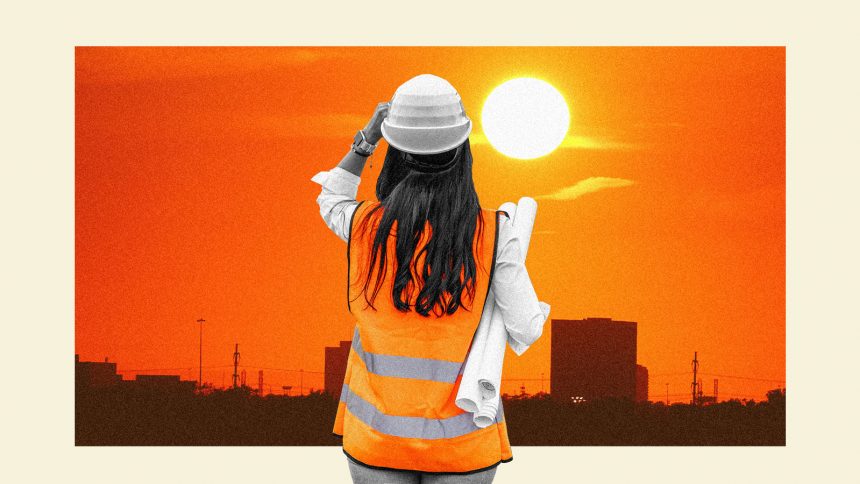This story was produced by Grist and co-published with USA Today. This story is part of State of Emergency, a Grist series exploring how climate disasters are impacting voting and politics, and is published with support from the CO2 Foundation.
Summertime heat in the United States has always put human health at risk. But the past few years have marked a departure from the historical norm — and the beginning of a new, far deadlier era. Last year was the hottest year registered globally since recordkeeping began in the mid-1800s.
In the northern hemisphere, scientists estimate that it was the hottest summer in the past 2,000 years. The summer of 2024, which has already set records, could be even hotter.
In early July, about 140 million people — approximately 42 percent of the American population — were simultaneously under some kind of heat alert. The record temperatures are more than an uncomfortable inconvenience.
Heat waves fill emergency rooms with heatstroke victims, kill agricultural workers picking produce in America’s countryside, overwhelm older adults in unairconditioned apartments, endanger children and pregnant people, melt asphalt and rail tracks, and ground 400,000-pound airplanes. The heat poses an existential threat, one that will grow more pronounced as we make our way deeper into the 21st century.
Once a month, roughly a dozen people enter a Zoom room to talk about what to do about this. They log on from their desks in Los Angeles, Phoenix, Jacksonville, San Antonio, and other cities across the country that are grappling with scorching temperatures.
They have backgrounds in public health, nonprofit work, government, and corporate sustainability. For an hour, this motley brigade of municipal officers — government officials who respond to extreme temperatures in their respective cities — share stories, tips, and warnings from across the country.
“They can just be really open with one another,” said Rae Ulrich, senior director of a climate resilience collaboration initiative housed at Arizona State University called Ten Across (10x), which organizes the monthly meetings. “They can share their vulnerabilities, major issues they have, they can learn from each other.”
The sharing of knowledge among local government personnel sounds mundane, but these people have taken on an unprecedented responsibility. City governments across the country rarely have someone dedicated exclusively to the issue of heat, despite the fact that dense, urban centers bear the brunt of extreme warmth.
Public health departments have historically shouldered the task of issuing warnings and advisories when heat waves descend, but there is no codified response to the crisis — no tested playbook to follow or federal agency to turn to in the event of an emergency. The Federal Emergency Management Agency, or FEMA, has never responded to a heat wave as a major disaster. The agency has said that heat could technically qualify as such an event, but there is still no criteria governing how it responds or doles out aid.
In 2021, the Atlantic Council’s Adrienne Arsht-Rockefeller Foundation Resilience Center, a Washington, D.C.-based think tank that aims to provide 1 billion people globally with the tools to become more resilient to climate change by the end of the decade, offered Miami-Dade County a matching grant to appoint the world’s first chief heat officer.
Since then, the organization has helped establish more heat officers around the globe, including positions in Mexico, Bangladesh, Greece, and Sierra Leone. In the U.S., there is now a chief heat officer in Phoenix, in Los Angeles, and, as of this year, in Arizona — the first-ever such position covering an entire state.
The officers come up with proposals to help cities adapt to extreme temperatures: tree-planting campaigns, reflective rooftops, spongy urban gardens to replace heat-trapping concrete. They design hand-held fans that have health recommendations written on them, distribute information about upcoming heat waves, and communicate with the public about the myriad risks of high heat.
They know how to bridge political divides within communities. To Republicans, they talk about the economic toll of extreme heat. With Democrats, they talk about health impacts. They serve as internal advocates for the people suffering the worst impacts of heat by working across city agencies to create emergency plans for when the next heat wave descends — where and when to open cooling centers and hydration stations, the fastest way to inform the public about health risks, and what to do when emergency rooms reach capacity.
They educate city officials who might not know that heat is the number one weather-related killer in the U.S.
Read Next How climate change drives hotter, more frequent heat waves Soon, heat officers began collaborating with other positions with similar mandates — chief resilience and sustainability officers in New York, Maryland, Louisiana, and Alabama, appointed by mayors or mandated by city climate change plans. Often, these climate leaders were working in a silo.
“Because extreme heat created this noise,” said Marta Segura, the chief heat officer for the city of Los Angeles, “it created this groundswell to address extreme heat across these positions that are very similar.”
As summers have gotten hotter, the weight of responsibility the officers feel has also grown. “It’s a lot to bear,” said Doug Melnick, chief sustainability officer in San Antonio, Texas. “We’re the ones thinking about what’s happening, what the impacts are going to be, and what to do about it.”
But there’s a problem. The vast majority of the officials working on this issue, who are appointed rather than elected, have no authority to actually put the measures they develop into place or require their respective governments to adhere to the recommendations they develop. It’s a searing irony: America’s chief heat officers, and the other types of officers who also work on heat issues, hold the key to protecting communities from rising temperatures, but there is absolutely no guarantee that mayors, governors, and lawmakers will listen.
And, in most cases, their funding depends on the political priorities of the party in power.
“There’s very little authority behind these positions,” said Richard C. Keller, a historian of medicine at the University of Wisconsin-Madison who wrote a book about extreme heat in Europe. “They can issue recommendations, they can help establish policy, but they’re going to have a very hard time enforcing those policies.”
It’s a sentiment echoed by other close observers of the response to extreme heat in the U.S. “They just don’t have power,” said Jeff Goodell, author of a seminal book on the health impacts of heat and heat politics called The Heat Will Kill You First. “What they can do is very limited.”
The fact that extreme heat, driven by human-caused climate change, is creating a slow-moving public health disaster across wide swaths of the United States should, in theory, spur immediate, bipartisan action. After all, heat does not recognize state lines or political identity — and it kills indiscriminately.
Recorded fatalities from heat have been rising nationwide in recent years. Officially, extreme temperatures were a factor in 2,300 U.S. deaths last year, a record. But the frustrating reality is heat-related mortality is almost always vastly undercounted.
No official figure comes close to capturing the actual public health impact of extreme heat because it is rarely registered as a cause of death by medical examiners. Despite myriad indications that the health repercussions of extreme heat are exacting an increasingly deadly toll, mounting a coordinated response to extreme heat in a country where everything is politicized has proven complicated.
Miami-Dade County Chief Heat Officer Jane Gilbert speaks during a news conference in May 2023.Wilfredo Lee / AP Photo Jane Gilbert, the first chief heat officer in the U.S., has been working to make Miami-Dade County more resilient to heat for three years now. Her policy prerogatives are at odds with the political priorities of her state’s Republican governor, Ron DeSantis.
In her position, Gilbert has advocated for policy measures that protect the county’s most vulnerable, including local legislation that requires better protections for people who work outside — from farmers to construction crews to mail carriers. “It’s that outdoor worker, it’s that person who can’t stay cool at home, it’s that person who has to wait at a bus stop for an hour that is not safe,” she told NBC News in March. A month later, DeSantis signed legislation approved by the Republican-controlled state Senate that prevents local governments from requiring employers to implement heat…






